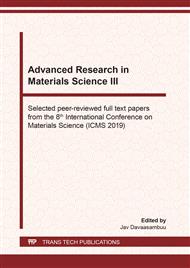[1]
S.A. Shabalovskaya, Surface, corrosion and biocompatibility aspects of Nitinol as an implant material. Bio-Medical Materials and Engineering. 12 (2002) 69-109.
Google Scholar
[2]
C. Wen, Metallic Foam Bone: Processing, Modification and Characterization and Properties, Woodhead Publishing, (2016).
Google Scholar
[3]
P.S. Liu, G.F. Chen, Porous Materials Processing and Applications. 1st ed. Elsevier Ltd., Oxford, UK, (2014).
Google Scholar
[4]
M.H. Elahinia, M. Hashemi, M. Tabesh, S.B. Bhaduri, Manufacturing and processing of NiTi implants: A review. Progress in Materials Science. 57 (2012) 911-946.
DOI: 10.1016/j.pmatsci.2011.11.001
Google Scholar
[5]
D. Kapoor, Nitinol for Medical Applications: A Brief Introduction to the Properties and Processing of Nickel Titanium Shape Memory Alloys and their Use in Stents. Johnson Matthey Technol. Rev. 61 (2017) 66-76.
DOI: 10.1595/205651317x694524
Google Scholar
[6]
T.J. Jeon, T.W. Hwang, H.J. Yun, C.J. VanTyne and Y.H. Moon, Control of Porosity in Parts Produced by a Direct Laser Melting Process. Appl. Sci. 8 (2018) 2573(1)-2573(16).
DOI: 10.3390/app8122573
Google Scholar
[7]
J.C. Chekotu, R. Groarke, K. O'Toole, D. Brabazon, Advances in Selective Laser Melting of Nitinol Shape Memory Alloy Part Production. Materials. 12 (2019) 809(1)-809(20).
DOI: 10.3390/ma12050809
Google Scholar
[8]
R.M. Khusnutdinoff, A.V. Mokshin, Electrocrystallization of supercooled water confined by graphene walls, J. Cryst. Growth. 524 (2019) 125182(1)- 125182(4).
DOI: 10.1016/j.jcrysgro.2019.125182
Google Scholar
[9]
R.M. Khusnutdinoff, A.V. Mokshin, Electrocrystallization of supercooled water confined between graphene layers, JETP Letters. 110 (2019) 557-561.
DOI: 10.1134/s0021364019200050
Google Scholar
[10]
J.M. Rodriques-Parra, R. Moreno, M.I. Nieto, Effect of cooling rate on the microstructure and porosity of alumina produced by freeze casting, J. Serb. Chem. Soc. 77 (2012) 1775-1785.
DOI: 10.2298/jsc121018132r
Google Scholar
[11]
W.-S. Ko, B. Grabowski and J. Neugebauer, Development and application of a Ni-Ti interatomic potential with high predictive accuracy of the martensitic phase transition, Phys. Rev. B 92 (2015) 134107 1-22.
DOI: 10.1103/physrevb.92.134107
Google Scholar
[12]
C. Braga, K.P. Travis, A configurational temperature Nose-Hoover thermostat. J. Chem. Phys. 123 (2005) 134101(1)-134101(15).
DOI: 10.1063/1.2013227
Google Scholar
[13]
F.A.L. Dullien, Porous Media. Fluid Transport and Pore Structure, Academic Press, (1992).
Google Scholar
[14]
L. Zhong, J. Wang, H. Sheng, Z. Zhang, and S.X. Mao, Formation of monatomic metallic glasses through ultrafast liquid quenching, Nature 512 (2014) 177-180.
DOI: 10.1038/nature13617
Google Scholar
[15]
A.V. Mokshin, B.N. Galimzyanov, D.T. Yarullin, Scaling relations for temperature dependences of the surface self-diffusion coefficient in crystallized molecular glasses, JETP Letters. 110 (2019) 511-516.
DOI: 10.1134/s002136401919010x
Google Scholar
[16]
B.N. Galimzyanov, V.I. Ladyanov, A.V. Mokshin, Remarkable nuances of crystallization: from ordinary crystal nucleation to rival mechanisms of crystallite coalescence. J. Cryst. Growth. 526 (2019) 125214(1)-125214(4).
DOI: 10.1016/j.jcrysgro.2019.125214
Google Scholar
[17]
Y. Li, C. Yang, H. Zhao, S. Qu, X. Li, Y. Li, New Developments of Ti-Based Alloys for Biomedical Applications. Materials. 7 (2014) 1709-1800.
DOI: 10.3390/ma7031709
Google Scholar
[18]
K. Prasad, O. Bazaka, M. Chua, M. Rochford, L. Fedrick, J. Spoor, R. Symes, M. Tieppo, C. Collins, A. Cao, D. Markwell, K. Ostrikov, K. Bazaka, Metallic Biomaterials: Current Challenges and Opportunities. Materials. 10 (2017) 884(1)-884(33).
DOI: 10.3390/ma10080884
Google Scholar
[19]
I.V. Shishkovsky, M.V. Kuznetsov, Yu.G. Morozov, Porous Titanium and Nitinol Implants Synthesized by SHS/SLS: Microstructural and Histomorphological Analyses of Tissue Reactions. International Journal of Self-Propagating High-Temperature Synthesis. 19 (2010) 157-167.
DOI: 10.3103/s1061386210020123
Google Scholar


